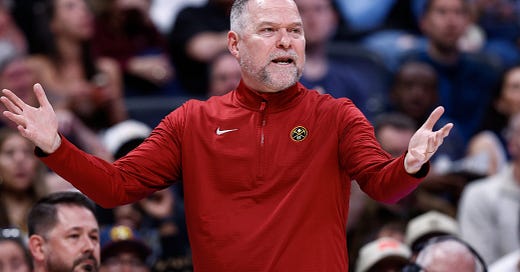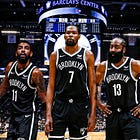There is a specter haunting the National Basketball Association — at least, it certainly feels like there is…
Twice, and potentially three times, this season, a team has done something basically unprecedented and hard to explain. First, of course, there was the Luka trade back in February. Then just last week, the Denver Nuggets fired their longtime coach, Michael Malone, with just three games left in the season, even though the Nuggets are going into the playoffs as the 4-seed in the West, and Malone is just two years removed from coaching the Nuggets to a championship.1
Two or three data points do not necessarily make a trend, but they do seem to cry out for an explanation. And as a historical materialist, my instinct is to look for explanations in changes to the relationship between owners and labor. Indeed, my strong suspicion is that both the Luka trade and the Malone firing are related to the NBA’s new collective-bargaining agreement. That CBA, which was agreed to in the summer of 2023, was part of a major owner backlash to player empowerment, and put much stricter limits on the league’s salary cap.
While the NBA has had a luxury tax for decades, the penalties for going over it were typically just financial: If a team spent above a certain threshold on salaries, then they had to pay a tax that was redistributed to teams below the cap. This meant that the only one who really suffered for going over the limit was the owner’s wallet. But many owners seemed to not mind paying the tax, especially for a few seasons at a time, especially if it meant adding groups of stars for a championship run. Hence the era of the superteam:
But in 2023, the league added a new level, the dreaded “second apron” and a bunch of serious, non-financial penalties to teams in the second apron. Now teams that spend too much can lose draft picks and be prohibited from signing free agents if they exceed the luxury tax by too much and for too long. This has dramatically and rapidly changed how teams approach roster construction, and I think both the Luka trade and the Malone firing are results of this.
In the case of the Luka trade, there was obviously some hesitation in the Dallas front office about signing Doncic to the supermax contract he would have been eligible for this summer. Under the old regime, a hesitant GM would probably just damn the torpedoes and sign the deal anyway, with the understanding that you could always build around Luka with another star player if it didn’t work out. Think of how the Warriors added Kevin Durant in 2016 or the Lakers added Anthony Davis in 2019. But now that such a move is a lot harder, and comes at a much greater cost, it makes more sense for a GM to preserve contract flexibility.
That’s what they’ve been doing over in Denver, which seems to have led to Malone’s firing. Even though the Nuggets won the Finals back in 2023 (right before the new CBA went into effect), many of the players from that team are no longer with the team. They haven’t lost any major pieces: Jamal Murray and Aaron Gordon and Michael Porter Jr. and of course Nikola Jokic are all still there. But they’ve replaced a lot of veteran rotation guys like Kentavious Caldwell-Pope and Jeff Green with younger players like Julian Strawther and Christian Braun.
This was done to keep the roster more affordable in the new CBA environment, but Coach Malone is well-known for preferring veterans to young players (hence the amount of playing time for Russell Westbrook this season), and the moves led to friction between him and the front office.
To be clear, none of this makes these moves good, or even that much less dysfunctional. Trading Luka was still a boneheaded decision that appears to have tanked the Dallas Mavericks for years. And it’s not clear how the Denver Nuggets will fare going into the playoffs after firing a coach who, even despite recent struggles, had them well-positioned to be the biggest threat to the Thunder in the Western Conference. So it’s not like these moves weren’t stupid.
But they didn’t invent stupid GMs in 2023. It’s always interesting how reluctant people are to explore materialistic explanations. They would much rather speculate about what people were thinking than look at how their underlying incentives may have changed.
And I think NBA fans have some reason to be concerned going forward. This CBA isn’t going anywhere, and I’m not sure we’ve seen the last boneheaded decision motivated by the new second apron…
The potential third thing was the Memphis Grizzlies firing Taylor Jenkins just a few days before Malone’s firing. This one wasn’t as shocking: the Grizzlies had replaced all of Jenkins’ assistants last offseason and most people expected him to be fired in the off-season. But Jenkins was still fired with just 10% of the season left despite the Grizzlies being in playoff position — something that doesn’t really have much precedent in NBA history.




